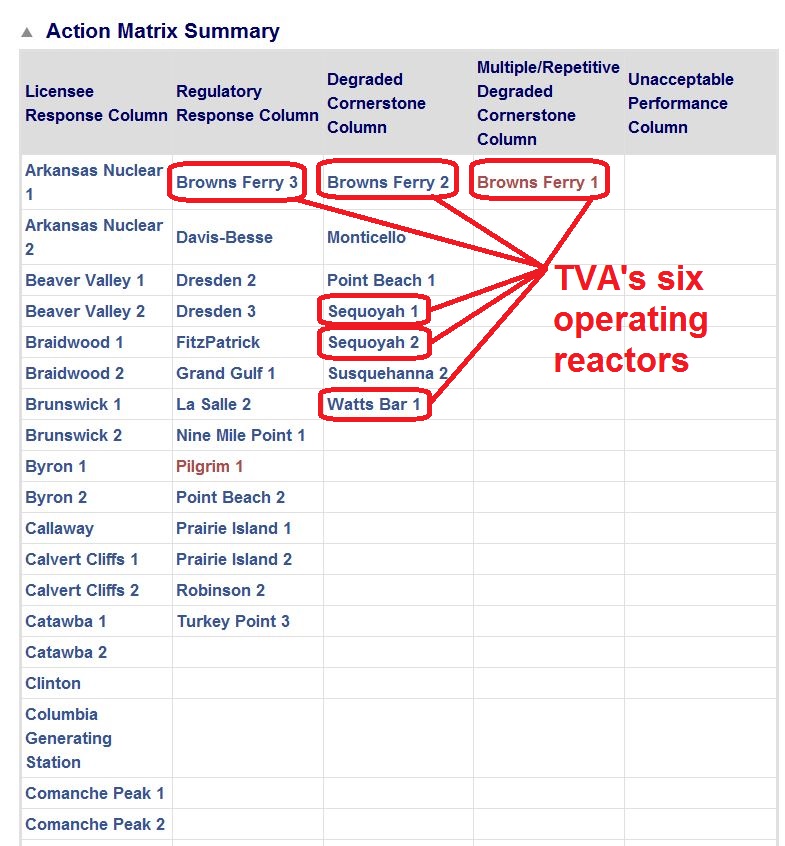Fission Stories #156
In spring 2010, the NRC introduced its Reactor Oversight Process (ROP) as its primary means of monitoring safety at the nation’s nuclear power reactors. The ROP uses information submitted by plant owners supplemented by findings from its inspectors to assess performance levels. The results are posted quarterly on the NRC’s website.
The ROP’s Action Matrix essentially summarizes the NRC’s assessment for each operating reactor.
The Action Matrix features five columns. When all performance indicators and NRC inspection findings reflect acceptable performance, the NRC places a reactor in the left-most column, called the Licensee Response Column. When performance indicators and/or inspection findings indicate declining performance, reactors more to the right through the Action Matrix’s columns.
As of October 28, 2013, 77 reactors were in the left-most column. Of the 23 other operating reactors:
- Fourteen (14) reactors were in the second column, called the Regulatory Response Column, indicating their performance dropped a little below acceptable levels.
- Seven (7) reactors were in the third column, called the Degraded Cornerstone Column, indicating performance had dropped a little deeper.
- One reactor was in the fourth column, called the Multiple/Repetitive Degraded Cornerstone Column, indicating an even deeper and broader performance decline.
- And one reactor was literally off the charts. The Fort Calhoun nuclear plant in Nebraska has been shut down since April 2011 and is being handled by the NRC via a separate monitoring process.
The Tennessee Valley Authority (TVA) owns six of the 23 reactors not in the Licensee Response Column. TVA owns five of the eight reactors in the third and fourth columns of the Action Matrix. In other words, TVA owns 62.5% of the worst performing reactors currently operating. Its three reactors at the Browns Ferry nuclear plant in Alabama occupy the second, third, and fourth columns of the Action Matrix—the only company to earn “Win,” “Place” and “Show” podium spots.
Our Takeaway
Why does TVA have six reactors outside of the acceptable column of the NRC’s Action Matrix?
Probably because TVA only operates six reactors. If it operated more reactors, their performance levels would likely be languishing too.
The worst performing reactor in the country—Browns Ferry Unit 1—was shut down between 1985 and 2007. Its two decade rest and recuperation didn’t prevent it from relatively quickly sinking to last place on the performance charts.
The three Browns Ferry reactors are of similar design and age to the two Brunswick reactors sitting comfortably in the Action Matrix’s first column.
The Sequoyah and Watts Bar reactors are of similar design and age to the two Catawba reactors sitting comfortably in the Action Matrix’s first column.
All of these reactors are in NRC Region II.
So, the performance differences aren’t due to reactor design, plant age, or regulator bias. TVA either has lower standards than other owners or is less capable of meeting high performance standards.
TVA’s bad report cards do not reflect an isolated problem at Browns Ferry or at Watts Bar. Instead, they reflect poor corporate competence that manifests itself in all things nuclear.
The NRC must ensure that TVA’s corporate malaise is remedied if the fixes applied to Browns Ferry, Sequoyah, and Watts Bar are to be both effective and enduring.
“Fission Stories” is a weekly feature by Dave Lochbaum. For more information on nuclear power safety, see the nuclear safety section of UCS’s website and our interactive map, the Nuclear Power Information Tracker.

